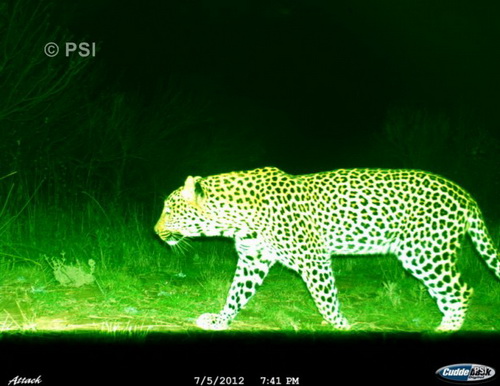Nestled between the agricultural regions of Paarl, Wellington and the Swartland, just 12km north-west of PaarlMountain, lies the rocky granite outcrop of Paardeberg. The Paardeberg is a privately owned mountain and various land-owners with mountain land form the Paardeberg Conservancy, which is housed within the Paardeberg Sustainability Initiative (PSI).
The view of Paardeberg (middle of the picture) from the western peaks of the Limietberg. Groenberg lies to the left, with Table Mountain in the far distance
The CLT Boland Project researchers Jeannie Hayward and Anita Meyer have previously received information that leopard footprints and scats (droppings) have occasionally been observed in the 5000ha wilderness area. There were even one or two actual leopard sightings reported in previous years. This was very exciting and intriguing news, since the Paardeberg outcrop is fairly small and isolated from the core Limietberg mountain range. An isolated outcrop such as this is generally not regarded as optimum habitat for a far-ranging, large predator such as the leopard, and it would generally not make up the core of an individual’s range.
However, the Boland Project study area is vast and covers the core mountain areas of the Limietberg, Jonkershoek, Hottentots-Holland and Kogelberg, and we do not have the resources to include all fringe habitat and inselbergs (isolated hills/mountains). This is where the participation of private landowners plays a vital role in the Boland Project research – landowners are continuously encouraged to purchase trail cameras of their own and contribute their photo data to the research.
Through the Botanical Survey Project (a project sponsored by the PSI and Anthony Ward of BWI member Vondeling Wines), the Paardeberg Conservancy obtained two trail cameras and did just that. In June 2012 we visited the Conservancy and accompanied PSI botanist Greg Nicolson to scout the area for two ideal spots to put up the cameras. While exploring the area, we found a tree with scratch marks on it, and just a short distance away, in the middle of the jeep track, a leopard scat containing porcupine quills. One of the cameras was promptly positioned at this spot and the other one a little further up on the mountain. Although very excited about the finds, we urged ourselves not to expect too much too soon from the cameras – camera-trapping leopards require some skill, a little bit of luck, and a huge amount of patience…

Scratch marks on a tree on Paardeberg
It was with great anticipation that we awaited the first set of photos downloaded from the Paardeberg cameras. Porcupine, baboon, genet and grysbok all frequented the road past the camera. There was even a set of two pictures, 9 minutes apart, of a caracal approaching a rock outcrop and returning with a fresh dassie kill! And lo and behold – to our great astonishment there was also a leopard picture. Although all evidence already lead us to believe that leopards do visit this inselberg, we by no means expected to get a photograph so quickly.
A leopard photo obtained by a camera trap on Paardeberg
These photos are an important contribution to the current knowledge about leopard distribution in the Boland area. Very little is known about how extensively inselbergs such as Paardeberg (as well as Kasteelberg and Piketberg etc) are utilised by leopards. Jeannie will shortly be launching a PhD study looking specifically at the habitat use and movement of leopards in fragmented, human-modified environment. This study will include the GPS collaring of certain leopards. The collars are fitted with a GPS device that records and stores the animal’s location via satellite. Analysis of these data will give a clear indication of the animals’ movement- and activity patterns as well as their habitat use. This information will aid in making important inferences about leopard distribution and home ranges in the Boland, as well as about how habitat modification and fragmentation impact on these animals.
We will be installing another one of these trail cameras, bought by private landowners in the Paardeberg Conservancy, at the end of August. If you are interested in purchasing a camera (±R3000) or making a contribution towards a collar (R25 000 to R45 000) – please feel free to contact us at [email protected]
The CLT is now an official beneficiary of the MySchool MyVillage MyPlanet fundraising programme. If you already have a MySchool card, please be sure to add the CLT as a beneficiary (you can support up to 3 beneficiaries) by updating your profile or calling 0860 100 445 during office hours. If you're not yet part of the MySchool initiative, please complete the online application form. You should receive your free card within a couple of weeks. You can use your card at any of the MySchool partners - including Woolworths, Kalahari.com, SupaQuick and Engen Quick Shops. Every swipe counts, so please start swiping - at no cost to you! Thank you for your support.
Warm Boland greetings
Anita & Jeannie

















